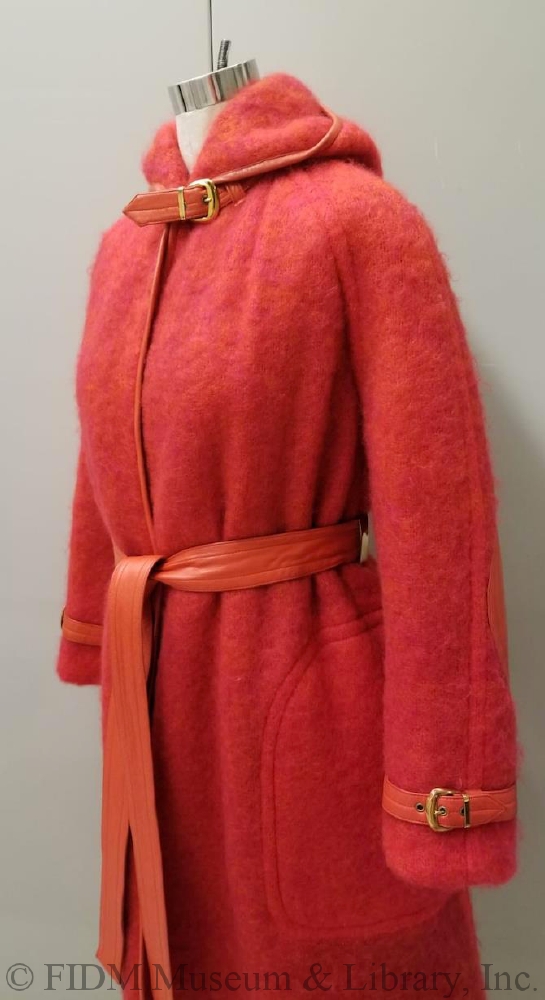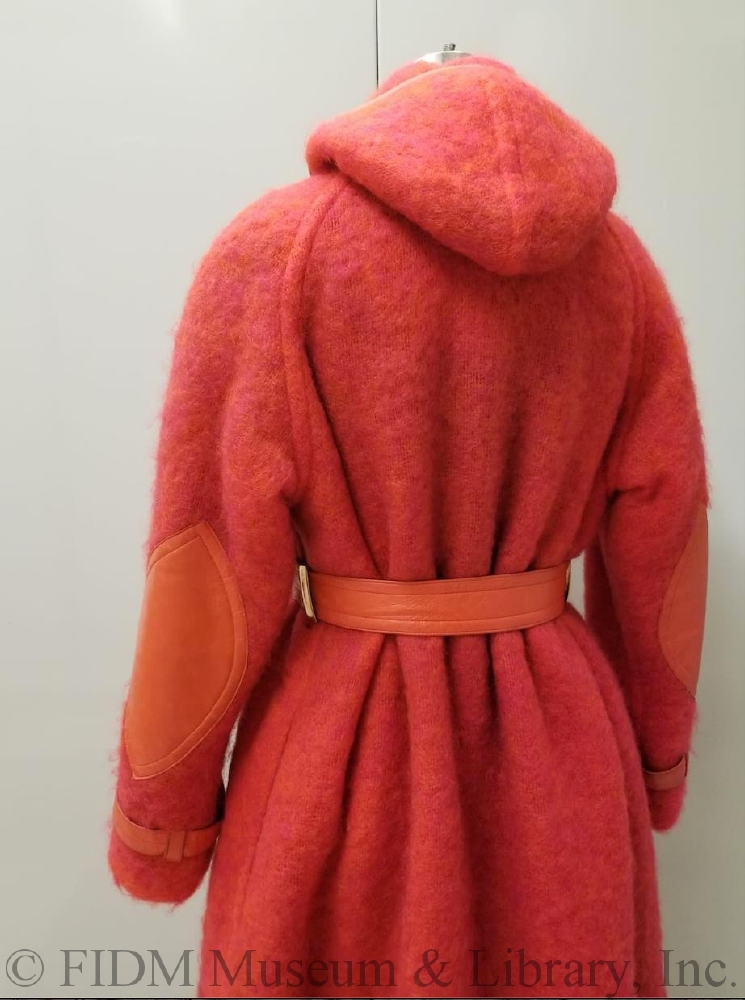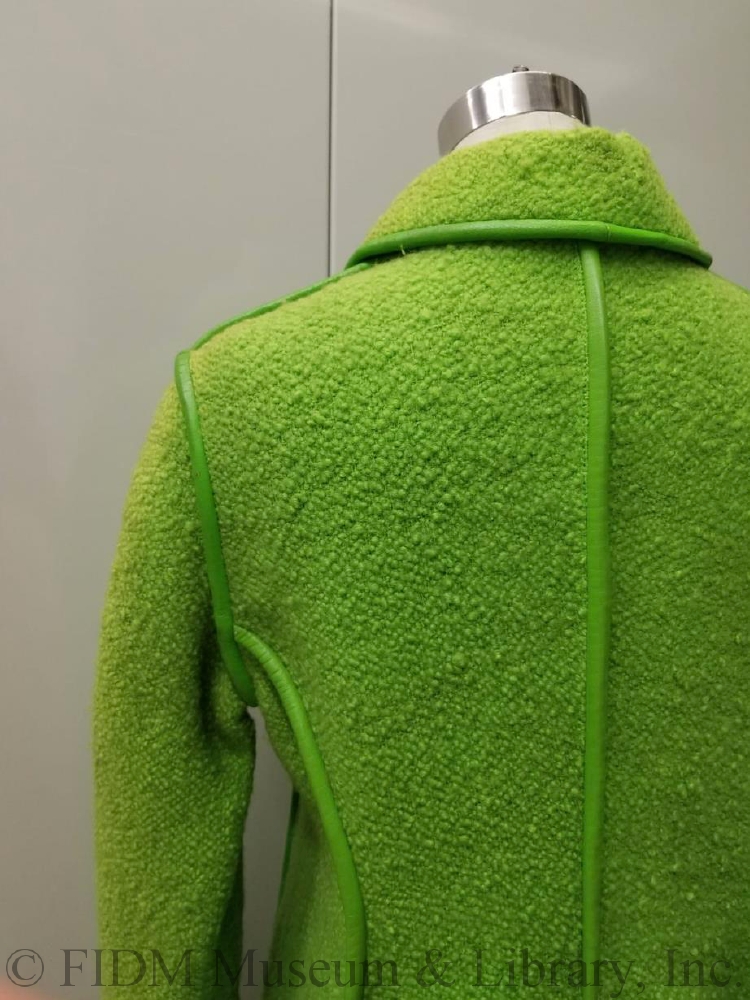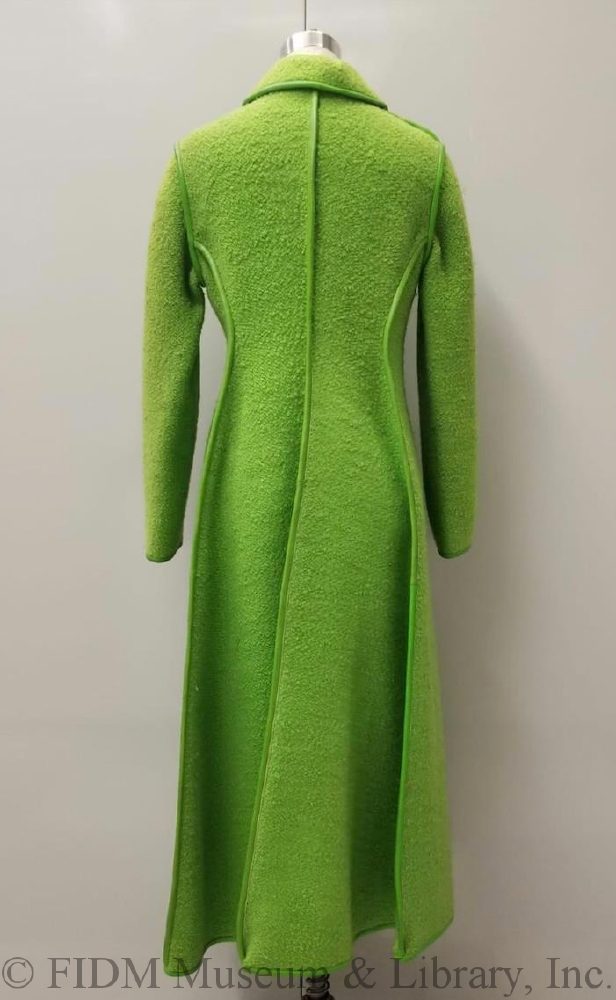Intern Report: Bonnie Cashin
Today's blog post is written by Nandini Gopalarathinam, recipient of the Santamaura Summer Study Grant. Nandini Gopalarathinam is a fashion professional turned aspiring fashion historian and archivist. After years of working as a visual director for brands like Donna Karan and Anthropologie, she decided to take a deeper dive into the historical, cultural, and social contexts of fashion. Currently, she is completing her final year of the dual degree M.A./M.S. program at New York University in Costume Studies and Library Science. Given her eclectic background, Nandini is most interested in exploring the intersection of global culture and trends in fashion and textiles. Besides starting work on her thesis this fall, she is planning a personal project to work with weavers in South India.
**********************************************************************
As someone who loves American brands and sportswear, the chance to intern at the FIDM Museum and work with objects from next year’s upcoming exhibition, Sporting Fashion: Outdoor Girls 1800 to 1960, was too good to pass up. During my internship, I had the chance to look at hundreds of objects of all kinds: from full-size vintage skis to dainty, hand-painted, French parasols. Since I have sportswear on the brain, the American designer Bonnie Cashin (1908-2000) was a natural choice for me to blog about. I’ve always loved Cashin—she designed clothes made to work with a modern woman’s lifestyle and incorporated her passion for travel and non-Western cultures into her designs. Two of her most notable silhouettes, the “Noh” coat, and the poncho, do just that, allowing Cashin to celebrate her love of beautiful textiles and simple but sophisticated shapes.
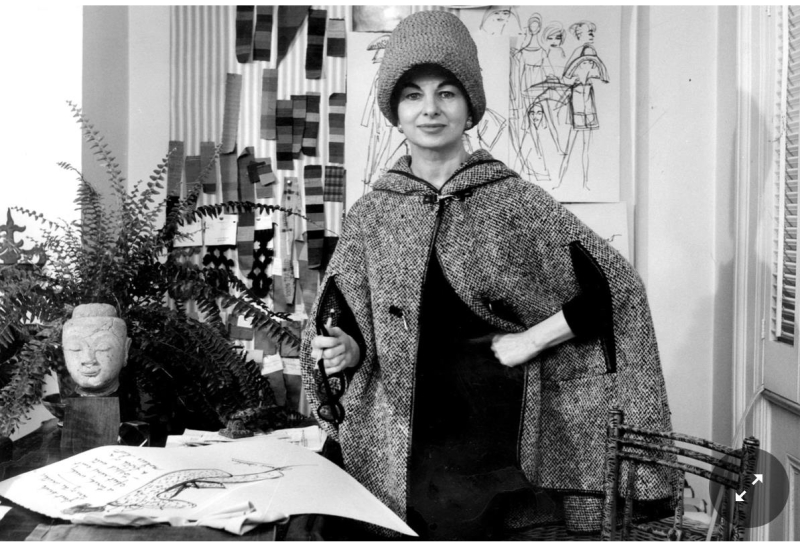 Bonnie Cashin in 1961. Bill Aller, The New York Times, May 11, 2016.
Bonnie Cashin in 1961. Bill Aller, The New York Times, May 11, 2016.
Cashin has often been credited with the invention of modern sportswear and introducing women to a system of layered dressing, but as a 2016 New York Times article pointed out, “for anyone under 40, her name doesn’t exactly resonate.”1 Stephanie Lake, the author of the book Bonnie Cashin: Chic is Where You Find It, and the owner of Cashin’s personal archives, is quoted in the article as saying, “Everyone from Miu Miu to Rachel Zoe has something in their collections that is specifically Bonnie.” 2 While Cashin isn’t the most mentioned muse for today’s fashion design stars, her influence can be seen in brands from Phoebe Philo’s Céline to JW Anderson as seen in this post by fashion industry watchdogs, Diet Prada.
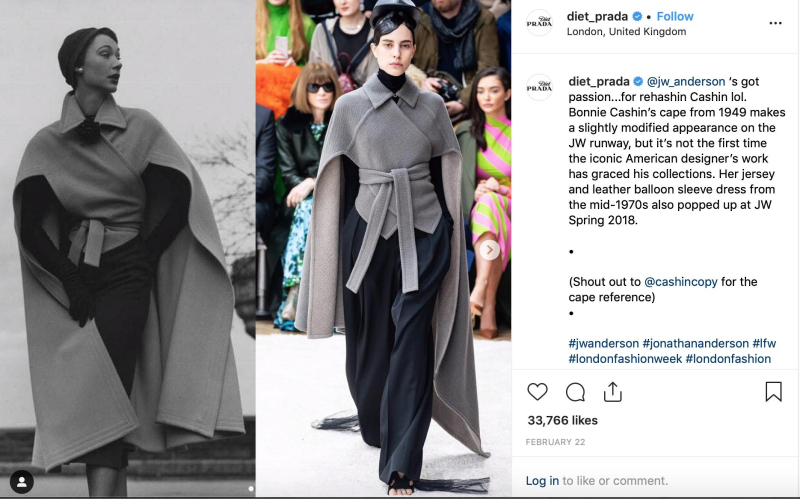 Diet Prada’s (@diet_prada) Instagram post from February 22, 2019.
Diet Prada’s (@diet_prada) Instagram post from February 22, 2019.
On a recent vintage shopping excursion in Brooklyn, NY, I came across a beautiful Bonnie Cashin for Russell Taylor raincoat. I’m obsessed with coats and was quite excited. Sleek, wool-lined, and with her signature turn-lock closures, it was just as perfect for 2019 as it was when Cashin originally designed it in the late 1970s. Given all of this, I thought it was high time to examine her influence via these two statement coats from the 1970s in the FIDM Museum Collection.
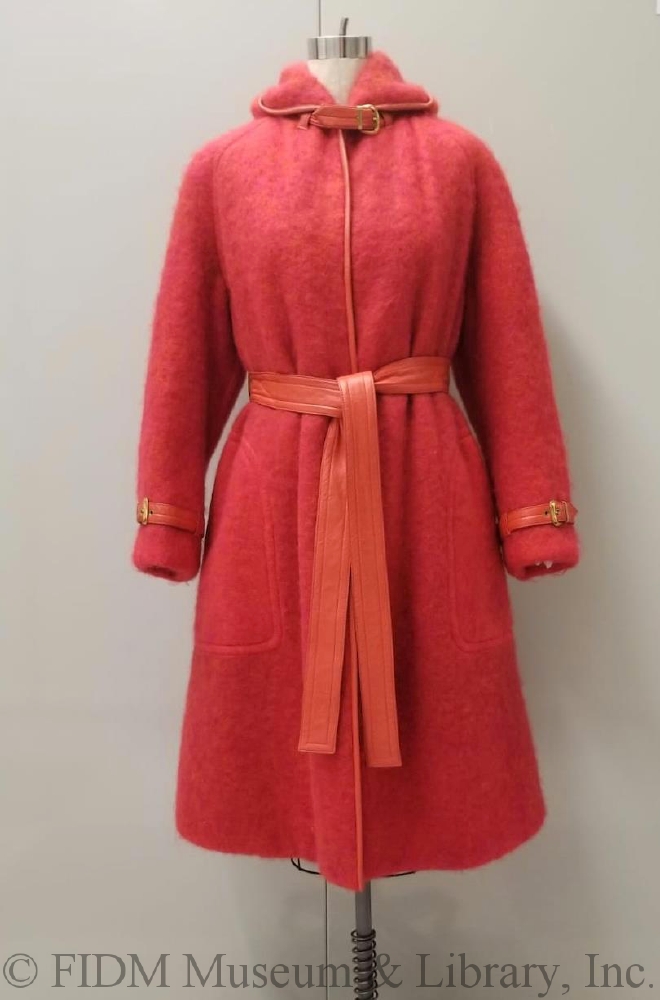
Coat Bonnie Cashin for Sills & Co. Fall 1972
Mohair, leather & metal
Gift of Helen and Phillip Sills
FIDM Museum Permanent Collection 80.649.16
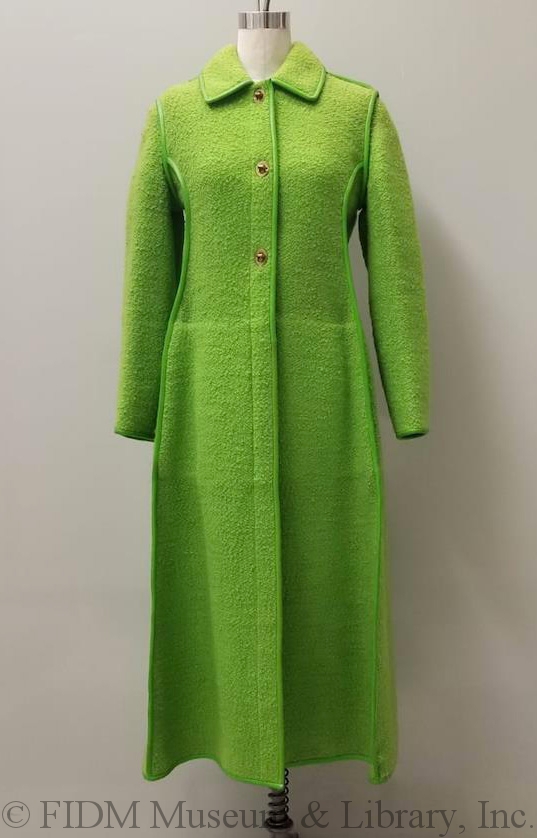
Coat Bonnie Cashin for Sills & Co. Fall 1970
Wool boucle & leather
Gift of Helen and Phillip Sills
FIDM Museum Permanent Collection 80.649.14
I chose these coats because they illustrate the wide range of Cashin’s design aesthetic, as well as her understanding of how women want and need to dress. The FIDM Museum collection has numerous Cashin pieces, including some really wonderful coats. They range in date from the 1950s to the 1970s and almost all have the Sills & Co. label, representing her work as head designer for the leather company headed by Phillip Sills from 1953-1977. The coats show many of Cashin’s trademark design details such as leather trim, large pockets, the use of unusual, textured wool blends, and her signature turn-lock closures. Cashin is well represented in museum collections, as Sills & Co. actively donated Cashin pieces to museums, as well as to universities around the country, from the 1960s to the 1980s. According to the FIDM Museum’s donor paperwork for these coats, both came from Sills & Co. as part of the above mentioned donation efforts. As seen in the detail shots of the red coat from Fall 1972, Cashin’s signature silhouette combines elements of a wrap coat with a classic duffel coat.
Made out of an iridescent pink and orange mohair, with large pockets, deep-set sleeves, a hood, and leather trim, this coat is easily identifiable as a Bonnie Cashin piece and has a Sills/Bonnie Cashin label. A May 5, 1972 article from Women's Wear Daily titled, “Cashin Classics” shows an illustration featuring two very similar coats. 3
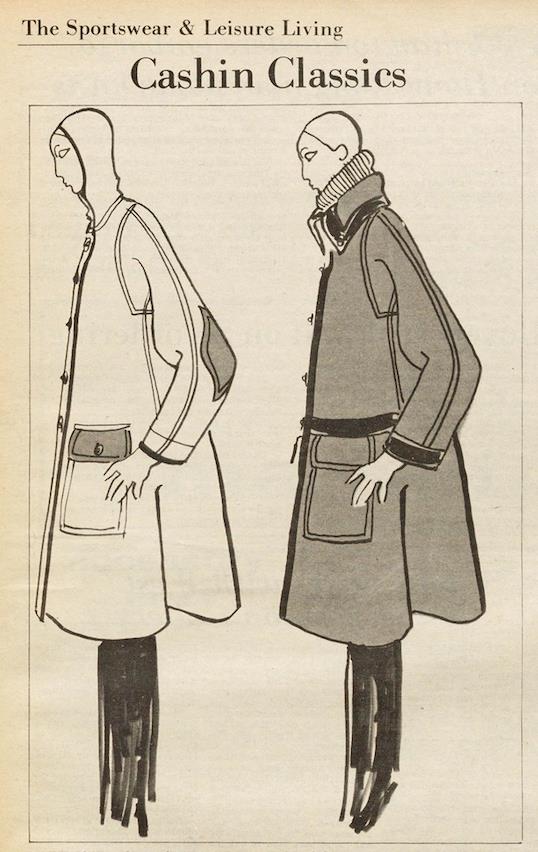
"Cashin Classics”, Women’s Wear Daily, May 5, 1972
In contrast to the red coat, the bright green coat from Fall 1970 piqued my curiosity because it looks like a Cashin coat in the choice of material, a nubby textured wool, the matching leather trim and, of course, her signature turn-lock closures. However, the longer, leaner cut of the coat as well as the higher-set sleeves aren’t typical of Cashin’s voluminous coat and cape silhouettes.
The coat also doesn’t have a label, which made me think that it may have been a prototype and was never produced for sale. However, a little digging revealed this image of the green coat in the FIDM Museum collection from the Milwaukee Journal, dated May 1969.4
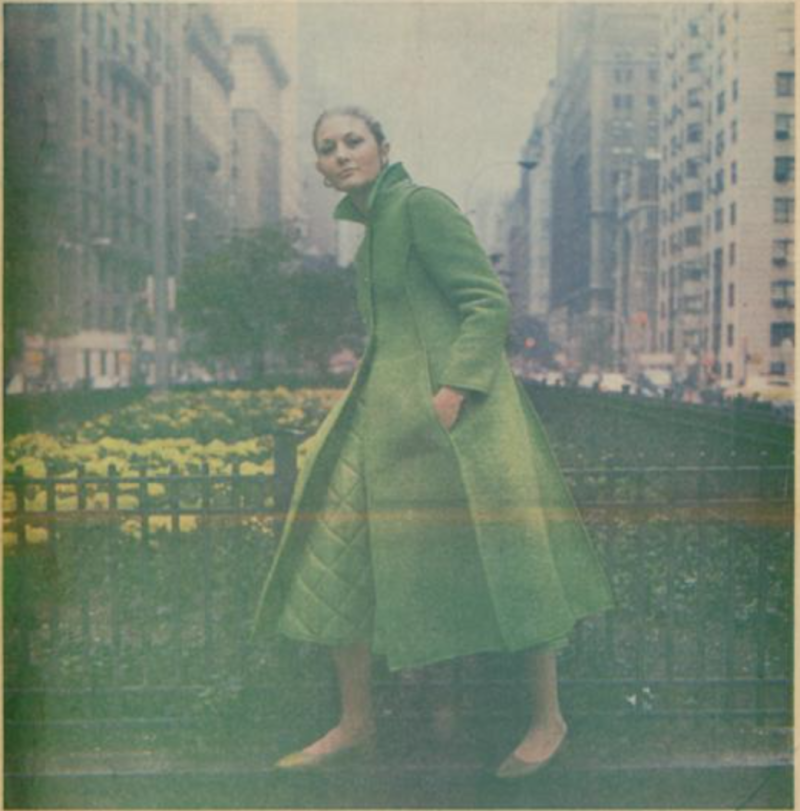 Bonnie Cashin Collection of Fashion, Theater, and Film Costume Design, University of California, Los Angeles, accessed August 5, 2019.
Bonnie Cashin Collection of Fashion, Theater, and Film Costume Design, University of California, Los Angeles, accessed August 5, 2019.
Apparently, the coat was part of a monochromatic look consisting of a quilted duvet ballet-length skirt and blouse, a look Cashin said was for leisure time, like poetry readings or Sunday brunch.5 These two coats provide a glimpse into Cashin’s expertise in outerwear and her imaginative design when it came to modern dress for women. A further deep dive into the FIDM Museum’s Cashin collection would be sure to reveal even more variations and creativity. For now, I will continue to appreciate what Bonnie Cashin has contributed to the overall world of American sportswear and continue to covet her timeless coats.
1 Petankas, Christopher, “The Forgotten Designer Behind Some of Fashion’s Biggest Trends”, New York Times, May 11, 2016, Section D, pg.7. 2 Petankas, “The Forgotten Designer Behind Some of Fashion’s Biggest Trends”, Section D, pg.7.
3 “Cashin Classics”, Women’s Wear Daily, May 5, 1972. 4 Bonnie Cashin Collection of Fashion, Theatre, and Film Costume Design, UCLA, accessed August 5, 2019. http://digital2.library.ucla.edu/viewItem.do?ark=21198/zz0028tv5t 5 Morris, Bernadine, "From Bonnie Cashin Cheerful Colors," New York Times, November 13, 1970, pg. 49.
